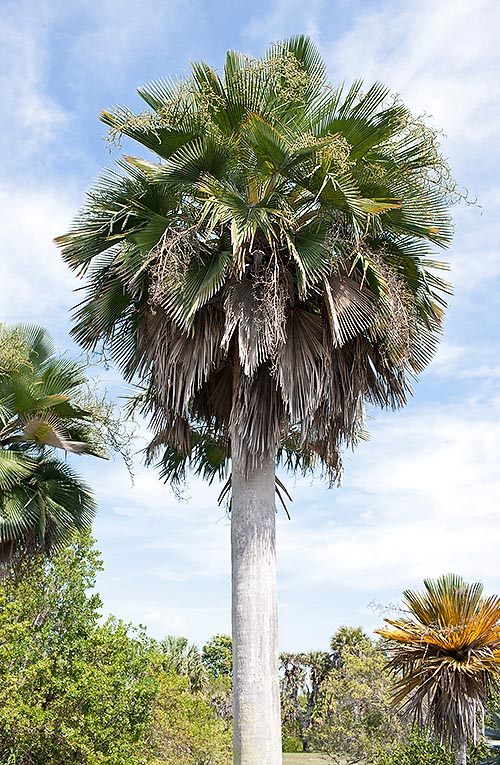Family : Arecaceae

Text © Pietro Puccio

English translation by Mario Beltramini

Even 20 m tall, Copernicia baileyana comes from Cuba © Giuseppe Mazza
The genus is honoured to the Polish astronomer Nicolaus Copernicus (1473-1543), the species to the American horticulturist and botanist Liberty Hyde Bailey (1858-1954).
Common names: Cuban paddle palm, Bailey palm, yarey palm (English); carnauba-de-Bailey (Portuguese-Brazil); yarey, yarey hembra, yareyòn (Spanish-Cuba).
The Copernicia baileyana León (1931) is a monoecious species, solitary, with stem up to about 20 m tall with a diameter of about 40 cm, often fusiform or with slight enlargement, up to 60 cm, at a certain height, covered by the remnants of the petioles of the old leaves in the young plants, smooth and of grey or whitish colour in the adult specimens.
The leaves, on a robust petiole, spiny at the margins, up to 1,3 m long and about 16 cm broad at the base and 8 cm at the apex, are numerous, palmate, orbicular, of 1,5-2 m of length, of green colour on the upper page, covered by a thin waxy greyish film below, divided into 110-130 segments particularly rigid united at the base for a part of their length.
Inflorescences among the leaves, up to 3 m long, extending beyond the leaves, much ramified, carrying yellowish hermaphrodite flowers with pointed corolla lobes, about 3 mm long, covered externally by a thick and hairy down, and 6 stamina. The fruits are globose, 1,8-2 cm long and of 1,8 cm of diameter, blackish when ripe, containing only one globose seed of about 1,2 cm of diameter.
It reproduces by seed in sandy soil kept humid at the temperature of 22-24 °C, the germination takes place in 1-3 months. Imposing species and among the most ornamental of the genus due to the columnar trunk and the thick leaves of rigid leaves, of relatively slow growth, cultivable in full sun in the tropical, subtropical climate zones, and, marginally, in the warm temperate ones, in the milder areas, where adult plants have resisted to exceptional drops of temperature, for a very short time, up to about -3 °C, but with damage to the foliage.
It is not particularly demanding about the soil, even poor, provided well drained, and can stand periods of drought, but meets regular waterings, besides of fertilizations, with a quicker growth. Of remarkable landscape value when employed in parks and very extensive gardens, isolated as well as in group or in rows.
The leaves are used as coverage of rural buildings and for manufacturing hats, bags, sandals and other handicrafts.
→ For general notions about ARECACEAE please click here.
